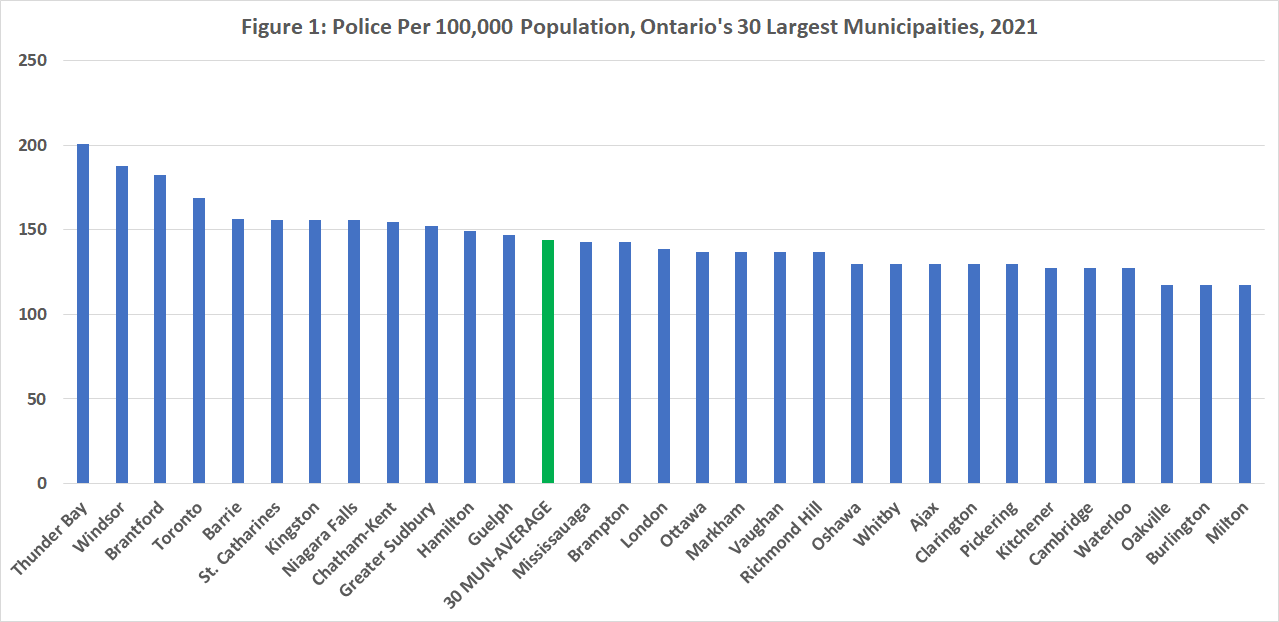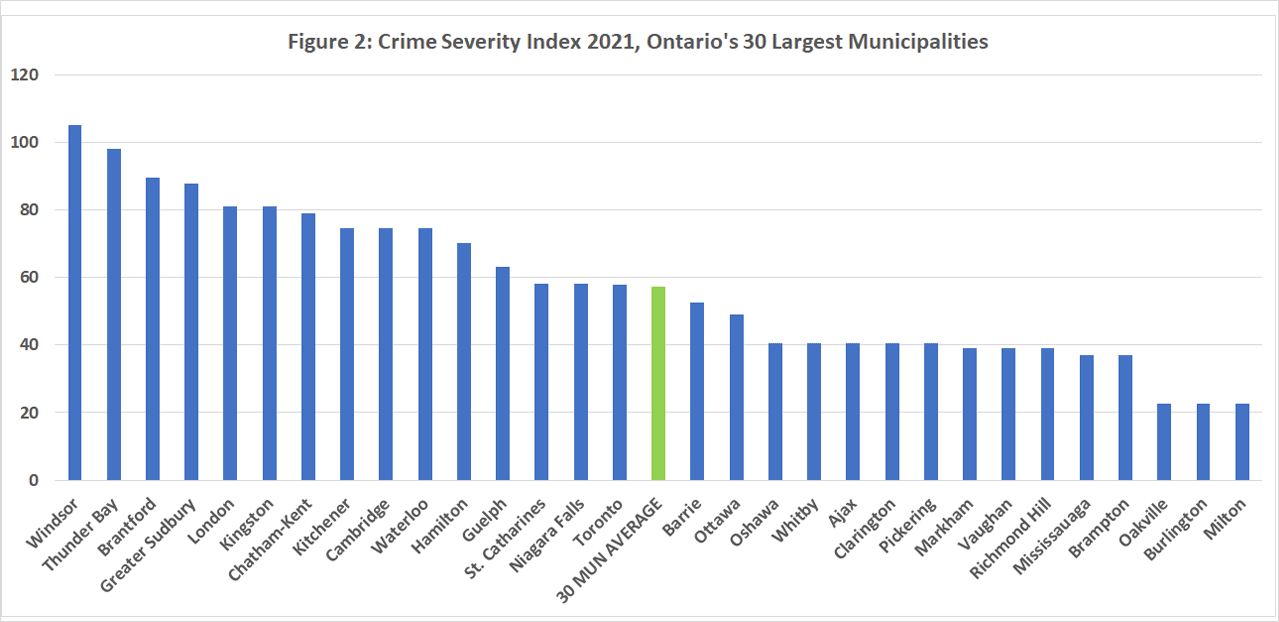Policing and Crime in Ontario, Part 2: severity and levels

This is the second post in a blog series examining crime and policing in Ontario.
While crime in Ontario has been rising recently, it’s still at comparatively low levels while the number the number of police officers per person is also relatively low. However, there are sometimes rather large differences across Ontario’s cities both in terms of police staffing, crime rates and crime severity. The reasons for these differences can be complex ranging from historical and institutional factors to geographic spread of municipalities and local policing environments rooted in different crime rates and types of crimes.
The chart below plots police officers per 100,000 population in 2021 for Ontario’s 30 largest municipalities by population and ranks them from highest to lowest. (Note that a number of these municipalities have regional police services and in the chart the per-person policing number for the regional service has been assigned to the municipality.) The average across these 30 municipalities is 144 officers per 100,000, which is below the provincial level of 176 per 100,000 reflecting higher police per 100,000 population in more rural or remote areas with large geographies and sparser populations.
The level of policing ranges from a high of 200.4 officers per 100,000 in Thunder Bay to a low of 117 per 100,000 for the set of communities in the Halton region—a substantial difference. The four highest number of officers per 100,000 are for Thunder Bay, Windsor, Brantford and Toronto, ranging respectively from 39 per cent to 17 per cent above the 30-municipality average of 144. Conversely, the four lowest communities of Milton, Burlington, Oakville and Waterloo (which incidentally are all part of regional forces) are respectively 12 per cent to 18 per cent below the average.
The second chart plots the ranked Crime Severity Index (CSI) for these 30 communities. The CSI is a relatively new tool that complements existing measures of traditional crime rates by taking severity and the volume of crime into account (Statistics Canada, 2009). All Criminal Code offences, including traffic offences and other federal statute offences, are included in the CSI. In the calculation of the CSI, each offence is assigned a weight, derived from average sentences handed down by criminal courts with more serious sentences on average for the crimes resulting in a higher weight for that offence. Thus, more serious offences (for example, homicides versus traffic offences) have a greater impact on changes in the index.
The results again show a substantial range in overall crime severity ranging from highs of 105 and 98 for Windsor and Thunder Bay to lows of about 23 for the Halton region communities of Oakville, Burlington and Milton with an average CSI across these 30 communities of 57. While there’s a wide range in crime severity across these Ontario cities, given that the CSI is standardized with Canada equal to 100, Ontario cities generally rank lower in crime severity than some other parts of Canada such as Manitoba, Saskatchewan and the Territories.
Again, it should be noted that a number of these municipalities have regional police services and the crime severity index as reported for the regional service has been assigned to the municipality. The communities with the highest crime severity are Windsor, Thunder Bay, Brantford and Sudbury, which range from 84 per cent to 54 per cent above the average crime severity. Meanwhile, for the communities at the bottom—Brampton, Oakville, Burlington and Milton—they are 35 per cent to 60 per cent below the average crime severity. Notably, the per cent differences from the average for crime severity across these communities is larger than the difference in policing resources.
Of course, when examining what crime is like in these same communities and ultimately what relation the municipality may have to policing resources, it’s important to bear in mind that the relationship between crime rates, crime severity and policing is bidirectional or somewhat murky. On the one hand, one would expect that more police, all other things given, should result in lower crime rates as more resources are brought to bear on the problems. At the same time, one might also find that higher crime rates spur calls for more police resources, which in turn results in the hiring of more police. Put another way, it’s sometimes difficult to sort out if more police officers result in less crime or more crime also leads to more police officers.
In the next post in this blog series, we’ll take a more in-depth look at the relationship between policing resources and crime severity in these Ontario communities.
Author:
Subscribe to the Fraser Institute
Get the latest news from the Fraser Institute on the latest research studies, news and events.



